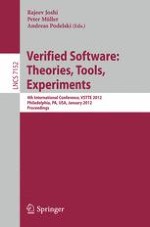This volume contains the proceedings of the 4th International Conference on Verified Software: Theories, Tools, and Experiments, VSTTE 2012, held in Philadelphia, PA, USA, in January 2012. The 20 revised full papers presented together with 2 invited talks and 2 tutorials were carefully revised and selected from 54 initial submissions for inclusion in the book. The goal of the VSTTE conference is to advance the state of the art through the interaction of theory development, tool evolution, and experimental validation. The papers address topics such as: specification and verification techniques, tool support for specification languages, tool for various design methodologies, tool integration and plug-ins, automation in formal verification, tool comparisons and benchmark repositories, combination of tools and techniques, customizing tools for particular applications, challenge problems, refinement methodologies, requirements modeling, specification languages, specification/verification case-studies, software design methods, and program logic.
